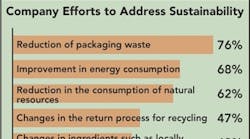Sustainable Packaging Initiatives Are a Viable Cost-Reduction Solution in a Downward Economy
The environment was a very hot topic last year. In fact "going green" and "carbon footprint" were two of the 10 most overused words of 2008, according to Lake Superior State University's annual list. No industry or business sector is immune to the demand by consumers for products and services that are more eco-friendly, environmentally free and biodegradable. With the recent emphasis on climate change and the affects of human activities on the environment, combined with the resulting regulations and requirements, sustainability has become an intrinsic component of operational strategies. However, while sustainability remains a key market driver, it exists amidst a myriad of meaningless catchphrases and jargon that have no measurable definition, driving manufacturers to ask themselves; what does it REALLY mean to be green?
Credible participants in the sustainability movement take a holistic approach to the process, follow the cradle-to-cradle concept and dismiss trendy words like green and eco-friendly. This holistic methodology focuses on reducing all greenhouse gases (GHG), rather than just the dominant element of carbon. Today, most companies focus on carbon, primarily because CO2 makes up approximately 93% of all GHG emissions in the U.S., according to the EPA. However, over time carbon's prominence as an industry focus in the movement is likely to dwindle, making it important to understand the difference.
It is clear that sustainability is top of mind across all industries and that packaging is a key driver. According to a recent study by AMR Research, 76% of sustainability efforts are focused on reducing packaging waste.
In the world of sustainable packaging, there is no more respected expert than the Sustainable Packaging Coalition (SPC). In a 2007 survey by the SPC and Packaging Digest magazine, 73% of 1,255 respondents who are involved in packaging reported that their companies had increased the emphasis on sustainable packaging with most of the attention on minimizing the carbon footprint through creative transportation, alternative fuels, and sustainable packaging efforts.
A key misconception is the belief that higher costs are intrinsically associated with sustainability efforts. The holistic approach affords visibility into the entire product lifecycle, from manufacturing and packaging, to delivery, recycling or disposition. When sustainable improvements are considered from this perspective, most organizations will realize a cost savings and positive impact on the bottom line.
In fact, a global leader in computer hardware and accessories was able to realize a savings of more than $500,000 in packaging and eliminated 99,183 pounds of packaging on 4.3 million products shipped.
The first step in an overall sustainable program is to analyze product packaging and supply chain processes to develop a model that reduces packaging size and minimizes operational and logistics activities that contribute to GHG emissions.
Packaging Design AssessmentMore compact packaging will result in a reduced material cost. By simplifying the packaging process with fewer pieces, you can extend the savings with less labor. The amount of warehouse space required is reduced, further impacting logistics costs. The domino effect continues through redesigning pallet configuration and shipping more product per pallet.
Ben Sligar, a global packaging engineer for ModusLink Global Solutions -- a provider of supply chain management solutions -- and a member of the Wal-Mart Packaging Sustainable Value Network and SPC, maintains that manufacturers can look to sustainable packaging redesign as a true driver of cost efficiency. "We've seen cost savings in almost every project, by using recycled materials and increasing the product to package ratio. For example, by moving clients to a trapped paperboard blister design and away from traditional clamshells that are not consumer friendly, we are able to reduce the amount of plastic and package size while increasing pallet density. In 2008 ModusLink converted more than 100 million clamshells to trapped blisters and we see the trend continuing."
Sustainable Materials
Understanding material patents, specialized material types, and their various sources is a critical element to a sustainability program. There are countless misnomers regarding what is recyclable or what truly is environmentally friendly. Most consumers believe that if a product is made out of a tree that it can be recycled and that plastics are bad for the environment, but that may not always be true. Polyethylene Terephthalate (PET) is a highly recyclable form of plastic if in a narrow neck form. Some foam and pulp products are not compostable. Not all fiberboards are 100% recyclable. There are a wide array of sustainable packaging materials available, including molded paper fiber, PaperFoam, recycled content plastics and papers and up and coming bio-polymers. The key is knowing the difference between them. And the energy required to create each material significantly influences the overall environmental impact. It's a good idea to check with local recycling centers to see what is recyclable in the region of operations.
Network Optimization
Once the package design analysis is complete, the entire supply chain should be optimized for when and where to perform packaging and fulfillment and for the lowest total GHG emissions. Network optimization can identify alternative supply chain models that leverage leading practices such as packaging postponement and deferred configuration. Reviewing the end-to-end supply chain illustrates how each part of the supply chain affects GHG emissions and helps to determine ways to optimize for GHGs that positively impact all other costs in the supply chain.
Packaging postponement entails an analysis of supply chain costs and the trade-offs among them, including materials, conversion, inventory and logistics. It is critical to measure each trade-off, including carbon emissions for logistics and all GHG emissions for operational activities. Operational emissions are typically based on megawatt hours and are derived by the geography's portfolio of energy consumption.
Manufacturers that are not currently examining their packaging programs are in danger of being left off the retail shelf. Wal-Mart is striving to achieve a 5% packaging reduction by 2013 and as of February 2008, requires all suppliers to enter its packaging information into the Wal-Mart Retail Link Scorecard. Further, Wal-Mart has promised to become "packaging neutral" by 2025, which means that, through recycling, reusing or perhaps even composting, Wal-Mart will try to recover as much material as was used in the packaging that flows through its stores.
As consumers become savvier to the green washing techniques employed by some manufacturers, and the retail industry demands clearly identifiable sustainable products, manufacturers will be required to join the sustainable movement. When these sustainable packaging projects are approached in a comprehensive manner and by professional resources, they frequently yield their own financial as well as environmental benefits. Beware the provider that is advocating its own particular shade of 'green' as it may not be the most suited to your products or your business objectives. Product independent advice usually yields the best results. What better way to compete in a world of green announcements than to be assured that your actions stand up to your 'green conscience' as well as external scrutiny?
Ryan Humphrey is the Director of Professional Services at ModusLink. ModusLink Global Solutions, Inc. is a provider of global supply chain business process management. www.moduslink.com.
Interested in information related to this topic? Subscribe to our weekly Value-chain eNewsletter.




